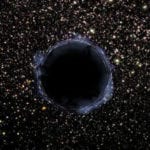 Mysteries
Mysteries  Mysteries
Mysteries  History
History 10 Surprising Stories About the Texas Rangers
 Humans
Humans 10 Philosophers Who Were Driven Mad by Their Own Theories
 Miscellaneous
Miscellaneous 10 Video-Game-Worthy Weapons and Armors from History
 Weird Stuff
Weird Stuff 10 Psychics Who Accurately Predicted Wartime Events
 The Arts
The Arts 10 Pieces of Art Inspired by a Broken Heart
 Health
Health 10 Science Fiction-Sounding New Medical Treatments
 History
History 10 Surprising Facts About the Father of Submarine Warfare
 Space
Space Ten Astonishing New Insights into Alien Worlds
 Weird Stuff
Weird Stuff 10 Bizarre Summer Solstice Rituals Still Practiced Today
 Mysteries
Mysteries Top 10 Haunting Facts About the Ghost Ship MV Alta
 History
History 10 Surprising Stories About the Texas Rangers
 Humans
Humans 10 Philosophers Who Were Driven Mad by Their Own Theories
Who's Behind Listverse?

Jamie Frater
Head Editor
Jamie founded Listverse due to an insatiable desire to share fascinating, obscure, and bizarre facts. He has been a guest speaker on numerous national radio and television stations and is a five time published author.
More About Us Miscellaneous
Miscellaneous 10 Video-Game-Worthy Weapons and Armors from History
 Weird Stuff
Weird Stuff 10 Psychics Who Accurately Predicted Wartime Events
 The Arts
The Arts 10 Pieces of Art Inspired by a Broken Heart
 Health
Health 10 Science Fiction-Sounding New Medical Treatments
 History
History 10 Surprising Facts About the Father of Submarine Warfare
 Space
Space Ten Astonishing New Insights into Alien Worlds
 Weird Stuff
Weird Stuff 10 Bizarre Summer Solstice Rituals Still Practiced Today
Top 10 Mind-Bending Unsolved Mysteries of the Universe
Have you ever looked up into the sky and wondered, “What’ s really out there?” Well, this is your chance to find out. We’re going where no man has gone before as we attempt to unravel the riddles of the cosmos. From the Big Bang to black holes, we’re leaving no stone—or space rock, it seems—unturned.
Together, let’s unlock the secrets that lie in the fabric of space and time. Here are the top 10 mind-bending unsolved mysteries of the universe.
Related: Top 10 Most Unusual Structures In The Universe
10 Dark Matter and Dark Energy: The Dark Duo
Despite making up around 95% of the universe, dark matter and dark energy remain one of the biggest puzzles in modern cosmology.
Dark matter makes up about 27% of the universe’s mass-energy content. Yet, we don’t know exactly what it is or how it interacts with regular matter, aside from its gravitational effects.
It’s like a silent artist sculpting our cosmos. We can’t observe it directly, but we do see its influence on the way galaxies rotate and cluster.
The gravitational effects of dark matter are most easily observed in the outer regions of galaxies, where stars move at speeds that aren’t possible unless there is more matter present than we can actually see.
Another proof is when light from distant galaxies passes through regions filled with dark matter, the light is bent in a phenomenon known as gravitational lensing. Looking at the Bullet Cluster, you can see this clearly.
Dark energy is no less of a mystery, making up 68% of the universe’s mass-energy content. It’s the force that appears to work against gravity on a cosmic scale.
In the 1920s, Edwin Hubble’s observations revealed an expanding universe, with galaxies moving away from each other. In 1998, studies showed this expansion wasn’t slowing down as expected; instead, it was accelerating. Dark energy was the name for the force causing this acceleration.
9 The Great Attractor and The Fate of the Milky Way
The Great Attractor is an intriguing cosmic anomaly hiding in the “Zone of Avoidance,” which is a fancy way of saying the section of the universe our galaxy’s cloud hides from view. It’s an area in space exerting a gravitational pull so strong it pulls galaxies, including our own, toward itself.
The Great Attractor is located about 220 million light-years away in the vicinity of the Norma SuperCluster, a cosmic neighborhood far denser and more populated than our own.
The obvious question is, when will our galaxy be destroyed by the Great Attractor?
The answer is never. The Milky Way is being pulled back by the Great Attractor. However, at the same time, dark energy is constantly pushing galaxies apart, meaning we will never collide with the cosmic anomaly.
What’s more likely is that the Great Attractor and the SuperCluster will get ripped apart by the expansion of the universe.
8 Where Is Everyone? The Fermi Paradox
Named after physicist Enrico Fermi, the Fermi paradox encapsulates a profound cosmic question. We know there are billions of galaxies, each teeming with billions of stars, and many of these stars likely have planets orbiting them. It makes sense mathematically that there are other intelligent life forms out there.
And yet, we find no real evidence of these civilizations. And that leaves us with Fermi’s question: “Where is everybody?”
With no evidence, there isn’t a clear answer, just theories. One possibility is that the cost of interstellar travel is too high, even for advanced civilizations.
Another theory is that the universe is filled with civilizations; we just happen to be in a cosmic backwater equivalent.
One of the more out-of-the-box theories is that we are part of a cosmic zoo, where other advanced beings observe us but don’t interact, deliberately keeping us in the dark. This one is a little too men in black for me.
No matter the theory you believe, the Fermi paradox is a good reminder that we have only just begun to explore the universe. Our knowledge about potential extraterrestrial life is limited to our own experiences. And while we keep expanding that knowledge, the question remains—where is everybody?
7 Fast Radio Bursts
Fast Radio Bursts (FRBs) are like the universe’s camera flash, illuminating the universe with flashes of energy that last milliseconds.
These intense flashes were first identified in 2007. A key feature of FRBs is their “dispersion sweep,” which is similar to radio pulsars. Basically, they send a variety of radio frequencies that arrive at different times because of the way they interact with the interstellar medium.
The origin of FRBs has always been uncertain. The initial excitement was followed by skepticism when a similar dispersion pattern was observed in multiple locations.
In 2013, four additional FRBs were discovered that shared key features with the previous bursts but had even higher dispersion measures, suggesting they traveled even further. This discovery suggested the universe could be full of these flashes.
Until an FRB can be traced to a specific galaxy or detected across different wavelengths, the full story behind them will remain a mystery.
6 The Cosmic Microwave Background Cold Spot
Cosmic microwave background (CMB) is radiation from the Big Bang. It covers the universe. Almost uniformly, there are, however, some small abnormalities. These act as cosmic breadcrumbs of sorts that lead back to the universe’s infancy. But there’s a patch, known as the Cold Spot, that’s not playing by the rules.
Its sheer size, coupled with a slightly lower temperature, is enough to cause cosmologists to ask why?
The leading theory was the CMB might have crossed the equivalent of an enormous cosmic desert, called a supervoid. These barren regions can zap energy from light crossing them due to their expansion over time. It’s kind of like a cosmic toll booth, causing the light to cool and redshift more than average.
But recent research has thrown a spanner in the works. This study suggests that known supervoids, even unseen ones, can’t account for the cold spot’s temperature dip or imposing size. Will we ever know where these cold spots come from?
5 Wow! Signal Origins
On August 15, 1977, astronomer Jerry Ehman detected a powerful, brief, and unique radio signal using Ohio State University’s Big Ear Radio Telescope. A signal that has never been repeated or detected again.
It was tightly constrained to a narrow band of radio frequencies, something nature doesn’t usually do. It also wasn’t a broadcast from Earth or a passing satellite. It was something else, something special, and it lasted 72 seconds.
Many, including John Kraus, the director of Big Ear, have suggested that the “Wow! Signal” could be a potential sign of extraterrestrial intelligence, as the signal’s characteristics were so unlike what we typically observe.
The hunt for its origins has continued ever since. Astronomers conducted a focused search for a Sun-like star that was considered a plausible source for the signal. It turned out to not fit the criteria. And the mystery is no closer to being solved.
4 Baryon Asymmetry: Nothing Should Exist
A fraction of a second after the Big Bang, the universe was brimming with particle-antiparticle pairs that, upon touching, obliterated each other, leaving nothing but pure energy behind. Makes sense so far.
But here’s the problem: If this perfect balance was the norm, we should have a universe full of energy and nothing else. Yet, here we are, surrounded by a universe filled with matter.
This means particles survived when they shouldn’t have, creating everything we see today. The preferential survival of matter over antimatter is what we call the Baryon Asymmetry Problem.
To try and explain this, scientists hope to use CERN’s Large Hadron Collider to study particles. One explanation that is being explored is that the laws of physics might not have been the laws of physics at the moment of the Big Bang.
Scientists have made some observations through processes like charge-parity violation, but nothing that clearly explains everything we know.
3 Supermassive Black Holes
Black holes are the ultimate conundrum. Think of an object so dense that no light can escape its gravitational pull. Now, make it millions to billions of times more massive than our Sun. That’s a supermassive black hole.
How do massive things like this form? We don’t actually know for sure. We have some theories, but since these behemoths literally birth galaxies, we aren’t certain.
The first theory is that, like their smaller, stellar-mass siblings, supermassive black holes might be formed from the gravitational collapse of a celestial object. In this case, it might be a massive gas cloud in the early stages of galaxy formation, like how a star forms, but on a vastly larger scale.
Another theory suggests that a regular stellar black hole could “eat” surrounding material over millions of years, gradually growing in size until it reaches “supermassive” status.
A similar theory is that when a cluster of stellar black holes collide, all their mass coalesces into one supermassive black hole.
Whatever the case, most astronomers concur that once formed, these supermassive black holes drive the activity of galaxies.
2 The Fine-Tuning Problem
The gist of the Fine-Tuning Problem is the realization that even slight adjustments to these fundamental laws and constants could lead to a universe where life as we know it can’t exist. Imagine tweaking gravity or the strong nuclear force just a smidge—this might mean no stars, no planets, no chemistry, and ultimately, no life.
Some of these constants, like the cosmological constant influencing the universe’s expansion rate, appear suspiciously fine-tuned to an almost unnatural precision.
Does this mean the universe was designed for life? Not necessarily.
Some scientists propose the Multiverse Theory as an explanation, where our universe is merely one of an infinite number, each with its unique set of laws and constants. We just happen to live in the one where conditions are right for life.
Essentially, it challenges us to question our understanding of the universe, its origin, and our place in it, inspiring new hypotheses and driving scientific exploration.
1 The Axion
Axions are the Houdinis of the particle world. In 1977, physicists noticed an oddity: Certain interactions between particles should have violated CP symmetry (the idea that the laws of physics remain unchanged when a particle is swapped with its antiparticle and inverted). But, surprisingly, they didn’t.
The hypothetical axion emerged as the solution to this conundrum, and they’re among the most promising candidates for dark matter. Scientists believe that these low-mass, low-energy axions could have been produced in huge quantities during the Big Bang and could now be filling the universe, explaining some puzzling observations in astrophysics.
They are still theoretical, but if scientists are successful in their experiments, we may finally get a lead on the identity of the universe’s missing mass content.








